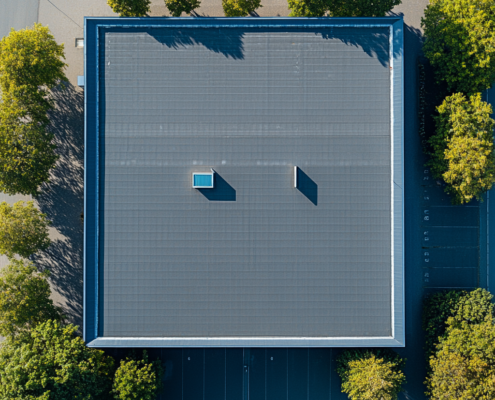
Flat roofs are ideal for maximizing usable space, providing extra room for patios, gardens, or HVAC systems.
Flat Roof Design: Everything You Need to Know for Durability and Functionality
Flat roof design is a popular choice for both commercial and residential buildings, offering several advantages such as cost savings, additional outdoor space, and modern aesthetics. However, flat roofs come with unique challenges, such as proper drainage and long-term durability. With the right materials and a well-thought-out design, flat roofs can provide reliable, efficient solutions for your property.
In this article, we’ll dive deep into the world of flat roof design, exploring the best materials for flat roofs, essential design considerations, and how to overcome common issues like water pooling and maintenance. We’ll also cover why choosing high-quality roofing systems, such as Duro-Last, can significantly improve the longevity and performance of your flat roof.
What Is Flat Roof Design?
Flat roof design refers to the architectural style where the roof is almost level or has a very slight pitch, usually less than 10 degrees. Despite the name “flat,” these roofs are typically designed with a slight slope to allow water runoff. Flat roofs are ideal for maximizing usable space, providing extra outdoor areas for patios, gardens, or HVAC systems. They are commonly found in commercial buildings, warehouses, multi-story residential buildings, and some modern homes.
While the design of flat roofs offers numerous benefits, it also requires proper materials and installation techniques to avoid common issues such as water pooling, leaks, and maintenance problems.
Advantages of Flat Roof Design
1. Cost-Effective Construction
Flat roofs are typically cheaper to build than pitched roofs because they require fewer materials and less labor-intensive construction. The absence of slopes or steep angles reduces the complexity and overall cost of installation.
2. Additional Usable Space
Flat roofs provide extra space for outdoor amenities. Whether you want a rooftop garden, a patio, or a space to install solar panels or HVAC systems, a flat roof offers ample room to get creative.
3. Easy Accessibility
Flat roofs are easier to access than traditional pitched roofs, making maintenance and repairs more straightforward and less costly.
4. Modern Aesthetic
Flat roof designs give buildings a sleek, contemporary look. This style is commonly used in modern architecture, creating a clean and minimalistic design.
5. Energy Efficiency
Flat roofs can be equipped with materials that promote energy efficiency, including cool roofing systems, insulation, or solar panel installations. These elements help reduce heating and cooling costs for your building.
Common Issues with Flat Roof Design
Although flat roofs offer several benefits, they do come with specific challenges. Without proper planning and materials, flat roofs can face issues such as:
1. Water Pooling
Since flat roofs have little or no slope, water can easily pool on the surface after rainfall. This pooling can lead to water damage, leaks, or even structural issues if not addressed properly.
2. Drainage Problems
Effective drainage is essential for any flat roof. If the drainage system is poorly designed or clogged, it can lead to water backup, which can damage the roof and building structure.
3. Increased Maintenance
Flat roofs tend to require more maintenance than sloped roofs, primarily due to their susceptibility to debris buildup, water pooling, and UV exposure. Regular inspections and cleaning are necessary to ensure the roof remains in top condition.
4. Temperature Extremes
Flat roofs can experience more temperature fluctuations than pitched roofs. Without adequate insulation or reflective coatings, flat roofs may absorb excessive heat in the summer and retain cold in the winter.
Best Materials for Flat Roof Design
Choosing the right materials is crucial to ensure the long-term durability and performance of a flat roof. Below are some of the most commonly used roofing materials for flat roof design:
1. TPO (Thermoplastic Olefin) Roofing
TPO is one of the most popular flat roofing materials due to its energy efficiency, durability, and ease of installation. TPO roofs are made from a blend of polypropylene and ethylene-propylene rubber, which makes them highly reflective and resistant to UV rays.
Benefits of TPO:
- Energy Efficiency: TPO’s reflective properties help reduce cooling costs by reflecting the sun’s rays.
- Durability: TPO roofs are resistant to tears, punctures, and UV degradation.
- Cost-Effective: TPO is generally less expensive than other options like PVC, making it an attractive choice for many commercial and residential flat roofs.
Considerations: TPO may require professional installation to ensure the seams are properly welded, as incorrect installation can lead to leaks.
2. EPDM (Ethylene Propylene Diene Monomer)
EPDM is a synthetic rubber roofing membrane widely used on flat roofs due to its long lifespan and resistance to various weather conditions. It is available in both black and white varieties and is known for its ability to withstand temperature fluctuations and harsh environmental conditions.
Benefits of EPDM:
- Longevity: EPDM roofs can last up to 50 years with proper maintenance.
- Weather Resistance: EPDM can withstand extreme temperatures, UV radiation, and heavy rainfall.
- Ease of Repair: EPDM membranes are easy to patch or repair if damage occurs.
Considerations: While EPDM is durable, it can be susceptible to punctures or tears, which may require timely repairs.
3. PVC (Polyvinyl Chloride) Roofing
PVC roofing systems are made from a durable plastic material that is resistant to chemicals, oils, and UV rays. They are a great option for flat roof designs that require a high level of durability and chemical resistance, especially in commercial and industrial applications.
Benefits of PVC:
- Chemical Resistance: PVC roofs are highly resistant to chemicals and pollutants, making them ideal for industrial buildings.
- Waterproofing: PVC membranes are completely waterproof and are highly effective in preventing leaks.
- Durability: PVC is resistant to punctures, tears, and fire, making it one of the most durable roofing materials available.
Considerations: PVC can be more expensive than EPDM or TPO, but it offers superior performance in harsh environments.
4. Duro-Last Roofing Systems
Duro-Last roofing systems are another excellent option for flat roof designs, especially for commercial and industrial applications. Duro-Last uses prefabricated, custom-fit roofing systems made from durable PVC material. These roofing systems are known for their longevity, energy efficiency, and ease of installation.
Benefits of Duro-Last:
- Custom Fit: Duro-Last roofing systems are custom-manufactured to the exact specifications of your roof, minimizing seams and the chance of leaks.
- Durability: Duro-Last roofs are highly resistant to punctures, tears, and extreme weather conditions.
- Energy Efficiency: The white PVC surface reflects UV rays, reducing the heat absorption of your building and lowering cooling costs.
Duro-Last’s prefabricated system ensures fewer seams, making it one of the most leak-resistant roofing systems available. For more information, visit duro-last.com.
5. Modified Bitumen Roofing
Modified bitumen is a hybrid roofing system made from asphalt and modified with polymers to enhance its flexibility and durability. It is often applied in multiple layers to create a robust roof system.
Benefits of Modified Bitumen:
- Durability: Modified bitumen is resistant to UV degradation, punctures, and cracking.
- Ease of Installation: It can be installed via hot-mop, self-adhesive, or torch-down methods.
- Cost-Effective: Modified bitumen is more affordable than other options like PVC or Duro-Last.
Considerations: While it is durable, modified bitumen requires proper installation to prevent leaks and damage from water pooling.
Factors to Consider in Flat Roof Design
1. Drainage System
Proper drainage is essential for any flat roof to prevent water from pooling. Roof drains, scuppers, and downspouts must be correctly placed and maintained to allow water to flow off the roof efficiently. Failure to address drainage can result in leaks, structural damage, or even roof collapse.
2. Slope and Pitch
Although flat roofs are designed to be level, they must still have a slight slope (typically between 1/8″ and 1/4″ per foot) to allow water to drain properly. A properly designed pitch ensures water will flow toward the drainage points, preventing standing water that can damage the roofing material.
3. Insulation
To maintain a comfortable interior temperature, flat roofs should be properly insulated. Insulation helps reduce heat loss in the winter and prevents excessive heat buildup in the summer. Foam insulation, fiberglass, and rigid board insulation are commonly used materials.
4. Maintenance Requirements
Flat roofs often require more frequent maintenance than pitched roofs due to their exposure to debris, water, and UV rays. Regular inspections and cleaning are essential to ensure your flat roof remains in good condition for years to come.
FAQs About Flat Roof Design
1. What is the best roofing material for flat roofs?
The best roofing material depends on your needs. TPO, EPDM, PVC, and Duro-Last are all excellent options. Duro-Last, in particular, is ideal for its custom fit and durability.
2. How long does a flat roof last?
With proper maintenance, flat roofs can last between 20 and 50 years, depending on the material. Duro-Last, for example, offers a lifespan of up to 40 years with minimal maintenance.
3. How do I prevent water pooling on a flat roof?
Ensure your roof has a proper slope for drainage, use high-quality waterproofing materials, and maintain the drainage system regularly to avoid water pooling.
4. Are flat roofs energy efficient?
Yes, flat roofs can be energy efficient, especially if they are coated with reflective materials or equipped with solar panels.
Choosing the Best Flat Roof Design
When considering a flat roof design, it’s essential to choose the right materials, address drainage issues, and ensure the roof is properly insulated. Materials like TPO, EPDM, PVC, and Duro-Last offer excellent performance, but Duro-Last’s custom-fabricated system stands out as one of the best options for long-term durability and energy efficiency. Proper design and maintenance will ensure your flat roof performs well, providing lasting protection for your building.







